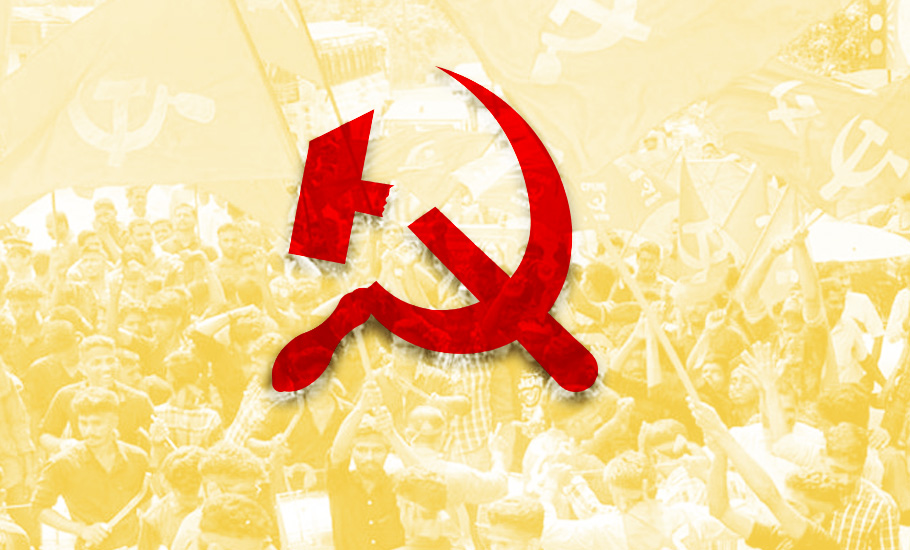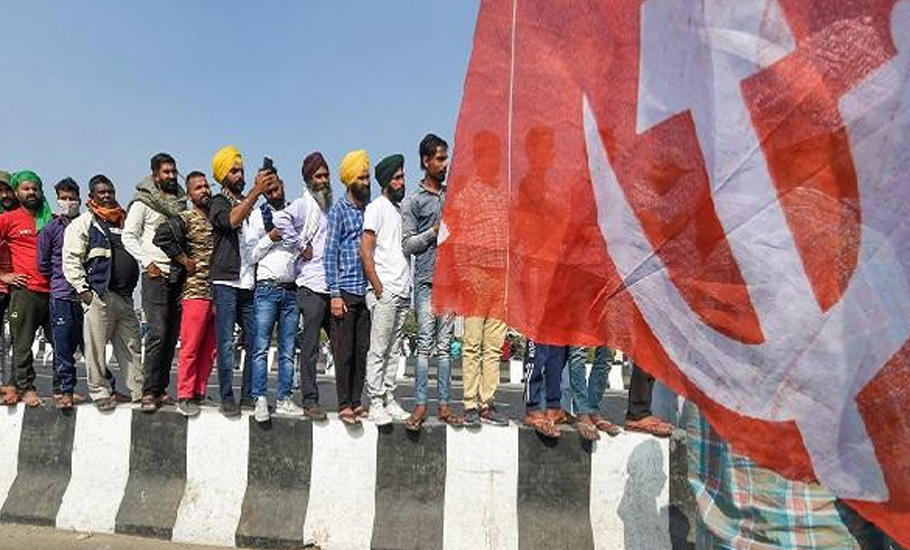
- Home
- News
- Analysis
- States
- Perspective
- Videos
- Education
- Entertainment
- Elections
- World Cup 2023
- Features
- Health
- Budget 2024-25
- Business
- Series
- NEET TANGLE
- Economy Series
- Earth Day
- Kashmir’s Frozen Turbulence
- India@75
- The legend of Ramjanmabhoomi
- Liberalisation@30
- How to tame a dragon
- Celebrating biodiversity
- Farm Matters
- 50 days of solitude
- Bringing Migrants Home
- Budget 2020
- Jharkhand Votes
- The Federal Investigates
- The Federal Impact
- Vanishing Sand
- Gandhi @ 150
- Andhra Today
- Field report
- Operation Gulmarg
- Pandemic @1 Mn in India
- The Federal Year-End
- The Zero Year
- Premium
- Science
- Brand studio
- Home
- NewsNews
- Analysis
- StatesStates
- PerspectivePerspective
- VideosVideos
- Entertainment
- ElectionsElections
- Sports
- Loading...
Sports - Features
- Budget 2024-25
- BusinessBusiness
- Premium
- Loading...
Premium

Why communist politics of classless society finds few takers in India

Siddhartha, a middle-class youth of the 1970s, was struggling to get a job amid rampant unemployment. In one of the many job interviews he faced, he was asked what the most significant and outstanding world event of the past decade was. After a brief pause, Siddhartha replied, “The war in Vietnam.” “More significant than man landing on the moon?” asked one of the interviewers,...
Siddhartha, a middle-class youth of the 1970s, was struggling to get a job amid rampant unemployment.
In one of the many job interviews he faced, he was asked what the most significant and outstanding world event of the past decade was. After a brief pause, Siddhartha replied, “The war in Vietnam.”
“More significant than man landing on the moon?” asked one of the interviewers, expressing surprise over the response of the interviewee.
“I think so,” Siddhartha replied, explaining that while the moon landing too was a remarkable achievement, it was not unpredictable as everyone knew it had to come about sometime. Whereas the extraordinary power of resistance of the ordinary people — not technology but plain human courage — was truly breathtaking.
Not convinced by the explanation, another interviewer asked dismissively, “Are you a communist?”
This scene from Satyajit Ray’s award-winning Pratidwandi (The Adversary), set against the backdrop of the Naxalite movement, depicted how communism or communists are viewed by most in India — a radical dogma that glorified war and violence.
Fifty years after the movie was made, communists and communism continue to be looked upon suspiciously in India by the powers that be, and any protesting youth and student are thus quickly dismissed as ‘urban Naxals’.
It is no wonder then that Marxist philosophy as a tool for socio-political change has failed to spread its influence beyond limited pockets in India despite communist red flags always dominating all important street protests in the country, including the ongoing agitations by farmers.
“Much of India, including most of its tallest leaders, finds the communist idea of violence unacceptable as a necessary or desirable means of class struggle to enforce parity,” observes Anand Kumar, a retired professor of sociology, Jawaharlal Nehru University.
This theory of violence as a means to enforce change is antithesis to the principle of nonviolence that was the bedrock of India’s freedom movement. Mahatma Gandhi himself once famously said that he would call himself a communist if communism shunned the path of violence.
Even Jawaharlal Nehru, who wanted India to be a socialist nation to end poverty and inequality, was against violence as an instrument of socio-political change.
Facing resistance
From its very inception in India, communism as an idea faced stiff resistance from ideals of non-violence preached and practiced by the greatest Indian of the modern era, Mahatma Gandhi.
The perception of communists as anarchists further gained ground by the widespread prevalence of political violence in those Indian states where communists have ever held power, be it Kerala, West Bengal or Tripura.
Further, communism as a socio-political ideology that envisages a classless society and perceives religion as the “opium of the people”, is inherently fraught with failure in Indian hierarchical caste-based social milieu that is deeply religious.
Despite inherent disadvantages, the Communist Party of India (CPI) formally formed in 1925 in Kanpur was able to make significant political inroads into independent India mainly by pushing for land reforms, fighting for social justice for lower castes and rights of farmers and workers.
In the three successive post-independence elections held in 1951, 1957 and 1962, the CPI had emerged as the principal opposition party to the ruling Congress. The first non-Congress government in independent India was formed by the party in Kerala under the leadership of EMS Namboodiripad.
The party, however, failed to keep the momentum after a large section of the communists, including Namboodiripad and Jyoti Basu, refused to back the Nehru government during the India-China war of 1962, which ultimately led to the split in the party in 1964 and formation of the CPI (Marxist).
The undivided CPI even took disciplinary action against VS Achuthanandan for mooting the idea of organising a blood donation camp for Indian soldiers during the war and contributing money to the government’s war fund to counter the charges that communists were Chinese agents.
Ever since, the ‘Chinese sympathiser’ tag has been stuck with the communists. In the 1970s, when the Naxalbari movement was at its peak, walls in Kolkata (then Calcutta) used to be adorned with portraits of Mao Zedong with the slogan “Chiner chairman amader chairman” (China’s chairman is our chairman)”.
The CPI (M), which became the largest communist party in the country after the 1964 split, continues to be in dilemma about whom to side with during any standoff between India and China.
“The government of India should come out with an authoritative statement as to what actually happened. It is imperative that both the governments immediately initiate high-level talks to defuse the situation and advance the process of disengagement on the basis of the agreed understanding of maintaining peace and tranquillity on the border,” the CPI (M) said in a statement issued after the violent skirmishes between China and India at Galwan valley in June this year.
Similarly, during the Doklam standoff of 2017, the CPI (M)’s official journal People’s Democracy wrote in an editorial: “It must be underlined that Bhutan has been negotiating with China directly on its border issues since the year 1984. It is better that India lets Bhutan take the lead in negotiating with China on the Doklam Plateau and other disputed territories. India can lend support to Bhutan’s position.”
Self-defeating politics
The CPI (M)’s stand on China is not the only electorally self-defeating position the party has taken over the years, hurting the communist cause in India, says Kolkata-based political commentator Nirmalya Banerjee.

The biggest opportunity to expand the communist footprints in India had come when the veteran Marxist and former West Bengal chief minister Jyoti Basu was propped up to head the United Front government at the Centre in 1996. But the CPI (M) turned down the offer denying a communist to lead the country.
Basu later famously described the party’s decision as a “historic blunder”.
“He termed it so not because he was denied the coveted office, but he was pragmatic enough to realise that the party had forgone the biggest ever opportunity to establish a national constituency for the communists,” Banerjee explained.
A communist prime minister in a democratic India within years of the collapse of the Soviet Union would have been a great boost for communism even outside India.
Strangely, even though the CPI (M) disowned the extremist Maoist idea of enforcing class equality through armed uprising and rather worked within the framework of democracy and a bourgeoisie-capitalist economy, it always shied away from joining any government at the Centre.
The CPI in contrast showed much more pragmatism on the issue of China as well as in becoming a partner in a Union government. Unfortunately for it after the 1964 split, the party has been reduced to a smaller partner in the larger communist family.
The communists again failed to gauge the people’s mood when the Left Front withdrew its support from the Manmohan Singh-led UPA government on the issue of the Indo-US nuclear deal in 2008.
Years later, the CPI (M) general secretary Sitaram Yechury admitted it was a mistake. But by then the damage was done. In the 2009 Lok Sabha elections, the Left parties won only 24 seats as against 59 in 2004. Its number further shrunk to just 12 in the 2014 elections and mere five in 2019.
At the crossroads
The electoral decline of the Left, however, does not mean that the communist agenda lost its relevance in India. If anything the current labour and farm unrests and growing economic disparity reinforce the need for a strong Left voice.
According to a Business Standard report, the combined wealth of India’s 90 super-rich people is equivalent to nearly a fifth of India’s gross domestic product (GDP). Their combined wealth increased by 33 per cent in 2020, whereas India’s economy, according to the International Monetary Fund (IMF), is expected to shrink by 9.6 per cent in the financial year 2020-21.
The above statistics point at India’s widening inequity and the government’s policy tilt favouring the rich over the poor.
The good showing of the Left parties in the recently held Assembly elections in Bihar and District Development Council (DDC) elections in Kashmir signals the possibility of revival of the communist movement in the country.
But to take further electoral advantage of the prevailing socio-economic situation, the Left in India needs to reinvent itself by becoming more realistic and flexible, and also revamp its organisational structure by making way for the next generation in leadership position.
The average age of the CPI (M) politburo is 69, with 82-year-old Ramachandran Pillai from Kerala being the oldest member and 63-year-old Mohammed Salim from West Bengal the youngest.
The last time the party infused young blood in its leadership structure was in 1985 when Prakash Karat and Sitaram Yechury, both in their 30s, were inducted into the party’s central committee.
The CPI (M) central committee, in fact, discussed the need to get younger people in leadership positions in its meeting in October last year and mooted a proposal for age-ceiling for members of its highest policy-making bodies, the party sources said.
On the policy front, the pre-poll alliance the Left struck with the Congress in West Bengal ahead of the 2021 elections is hailed as a right step in that direction. But at the same time many point out that the Left Front strategy of treating the BJP and the Trinamool Congress as equal enemies is again a self-destructive approach.
For this, Communist Party of India (MarxistLeninist) Liberation general secretary Dipankar Bhattacharya has been suggesting that the communist parties in West Bengal must aim at defeating the BJP by treating it as a bigger enemy than the TMC.
The fact that the CPI (M) leaders refuse to pay heed to a fellow communist without deliberating over it even once is indicative of their reluctance to change. And change is what the communist movement in India needs the most right now.

